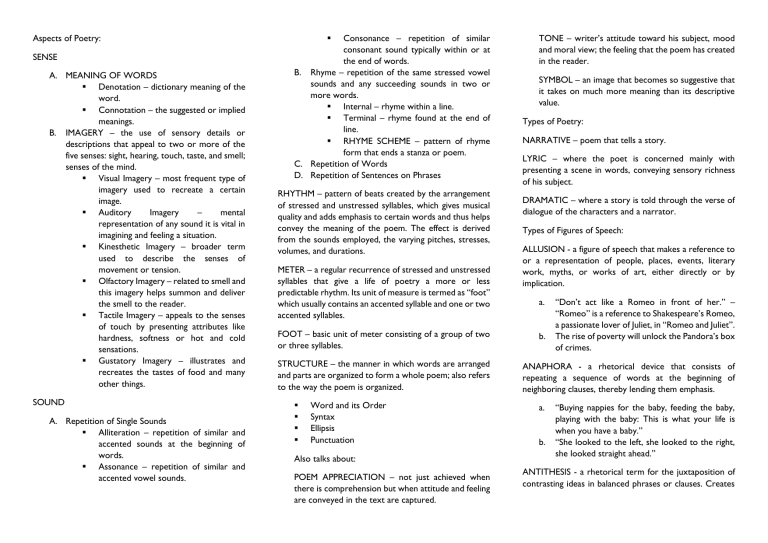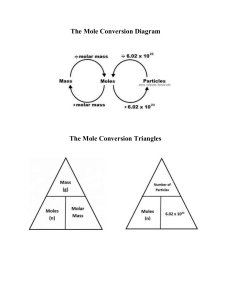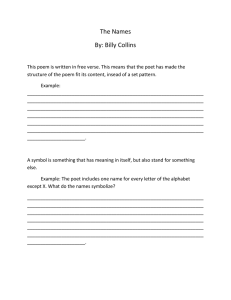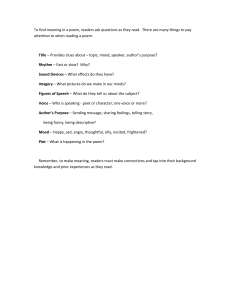
Aspects of Poetry: SENSE A. MEANING OF WORDS ▪ Denotation – dictionary meaning of the word. ▪ Connotation – the suggested or implied meanings. B. IMAGERY – the use of sensory details or descriptions that appeal to two or more of the five senses: sight, hearing, touch, taste, and smell; senses of the mind. ▪ Visual Imagery – most frequent type of imagery used to recreate a certain image. ▪ Auditory Imagery – mental representation of any sound it is vital in imagining and feeling a situation. ▪ Kinesthetic Imagery – broader term used to describe the senses of movement or tension. ▪ Olfactory Imagery – related to smell and this imagery helps summon and deliver the smell to the reader. ▪ Tactile Imagery – appeals to the senses of touch by presenting attributes like hardness, softness or hot and cold sensations. ▪ Gustatory Imagery – illustrates and recreates the tastes of food and many other things. SOUND A. Repetition of Single Sounds ▪ Alliteration – repetition of similar and accented sounds at the beginning of words. ▪ Assonance – repetition of similar and accented vowel sounds. Consonance – repetition of similar consonant sound typically within or at the end of words. B. Rhyme – repetition of the same stressed vowel sounds and any succeeding sounds in two or more words. ▪ Internal – rhyme within a line. ▪ Terminal – rhyme found at the end of line. ▪ RHYME SCHEME – pattern of rhyme form that ends a stanza or poem. C. Repetition of Words D. Repetition of Sentences on Phrases ▪ RHYTHM – pattern of beats created by the arrangement of stressed and unstressed syllables, which gives musical quality and adds emphasis to certain words and thus helps convey the meaning of the poem. The effect is derived from the sounds employed, the varying pitches, stresses, volumes, and durations. METER – a regular recurrence of stressed and unstressed syllables that give a life of poetry a more or less predictable rhythm. Its unit of measure is termed as “foot” which usually contains an accented syllable and one or two accented syllables. FOOT – basic unit of meter consisting of a group of two or three syllables. STRUCTURE – the manner in which words are arranged and parts are organized to form a whole poem; also refers to the way the poem is organized. ▪ ▪ ▪ ▪ Word and its Order Syntax Ellipsis Punctuation Also talks about: POEM APPRECIATION – not just achieved when there is comprehension but when attitude and feeling are conveyed in the text are captured. TONE – writer’s attitude toward his subject, mood and moral view; the feeling that the poem has created in the reader. SYMBOL – an image that becomes so suggestive that it takes on much more meaning than its descriptive value. Types of Poetry: NARRATIVE – poem that tells a story. LYRIC – where the poet is concerned mainly with presenting a scene in words, conveying sensory richness of his subject. DRAMATIC – where a story is told through the verse of dialogue of the characters and a narrator. Types of Figures of Speech: ALLUSION - a figure of speech that makes a reference to or a representation of people, places, events, literary work, myths, or works of art, either directly or by implication. a. b. “Don’t act like a Romeo in front of her.” – “Romeo” is a reference to Shakespeare’s Romeo, a passionate lover of Juliet, in “Romeo and Juliet”. The rise of poverty will unlock the Pandora’s box of crimes. ANAPHORA - a rhetorical device that consists of repeating a sequence of words at the beginning of neighboring clauses, thereby lending them emphasis. a. b. “Buying nappies for the baby, feeding the baby, playing with the baby: This is what your life is when you have a baby.” “She looked to the left, she looked to the right, she looked straight ahead.” ANTITHESIS - a rhetorical term for the juxtaposition of contrasting ideas in balanced phrases or clauses. Creates a balance between opposite qualities and lend a greater insight into the subject. a. b. “All the joy the world contains has come through wishing happiness for others. All the misery the world contains has come through wanting pleasure for oneself.” –Shantiva “…ask not what your country can do for you, ask what you can do for your country. My fellow citizens of the world: ask not what America will do for you, but what together we can do for the freedom of man”. –John F. Kennedy APHORISM - a statement of truth or opinion expressed in a concise and witty manner. It is necessary for a statement to contain a truth revealed in a terse manner. Aphorisms often come with a pinch of humor, which makes them more appealing to the masses. a. b. “A proverb is no proverb to you till life illustrated it.” –John Keats “Life’s tragedy is that we get old too soon and wise too late.” –Benjamin Franklin APOSTROPHE - a figure of speech in which some absent or non-existent person or thing is addressed as if present and capable of understanding or replying. a. “Oh! Stars and clouds and winds, ye are all about to mock me; if ye really pity me, crush sensation and memory; let me become as nought; but if not, depart, depart, and leave me in darkness.” – Mary Shelley, Frankenstein, 1818 HYPERBOLE - involves an exaggeration of ideas for the sake of emphasis. a. b. I am dying of shame. She shed a flood of tears. IRONY - refers to how a person, situation, statement, or circumstance is not as it would actually seem. Many times, it is the exact opposite of what it appears to be. It can be situational, dramatic, or verbal. a. b. I enjoyed the movie as much as getting a root canal. Exclaiming “oh great” after failing an exam. LITOTES - a figure of speech consisting of an ironical understatement in which affirmative is expressed by the negation of the opposite. This is mainly done through double negatives. a. b. “Not too bad” for “very good” confirms a positive idea by negating the opposite. Einstein is not a bad mathematician. METAPHOR - an implied comparison between two unlike things that actually have something important in common. a. b. The world’s a stage. He has a lion in battle. METONYMY - a figure of speech in which one word or phrase is substituted for another with which it is closely associated.; also, the rhetorical strategy of describing something indirectly by referring to things around it. a. b. “The pen is mightier than the sword”. (Pen stands for thought and reason, while sword represents physical warfare.) Malacanang will be announcing the decision around noon today. (Malacanang- in place of the president) OXYMORON — a figure of speech in which two opposite ideas are joined to create an effect. a. b. Awfully pretty Bittersweet PARADOX - from the Greek word “paradoxon” that means contrary to expectations, existing belief or perceived opinion. It is a phrase or statement that seems to be impossible or contradictory but is nevertheless true, literally or figuratively. a. War is peace Freedom is slavery b. Ignorance is strength -George Orwell, 1984 Save money by spending it. PESONIFICATION - a figure of speech in which an inanimate object, an animal or idea is endowed with human qualities or abilities. a. b. The fire swallowed the entire forest. The wind whispered through dry grass. SIMILE - a stated comparison (usually formed with “like”, “than,” or “as”) between two fundamentally dissimilar or unlike things that have certain qualities in common. a. b. He is as cunning as a fox. The water well was as dry as a bone. SYNECHDOCHE- a figure of speech in which a part is used for the whole, the whole for a part, the specific for the general, the general for the specific, or the material for the thing made from it. a. b. Twenty sails came to the harbor. (sails refer to the ships, naming the part to mean the whole) The word “Coppers” often refers to coins. SYNESTHESIA - refers to a technique adopted by writers to present ideas, characters or places in such a manner that they appeal to more than one senses like hearing, seeing, smell, etc. at a given time. a. b. The sound of her voice was sweet. (Sweet has something to do with taste and not sound.) “loud colors”, “frozen silence”, etc. UNDERSTATEMENT - a figure of speech in which a writer or a speaker deliberately makes a situation seem less important or serious than it is. a. “treehugger” for environmentalist calling the Atlantic Ocean “the pond” I, HIGAONON ▪ Telesforo S. Sungkit Jr. ▪ ▪ From Sumilao, Bukidnon A farmer and a natural farming advocate ▪ ▪ HIGA – living GAON – mountains ▪ ONON – people HIGAONON – people living in the mountains ▪ ▪ ▪ ▪ ▪ ▪ ▪ ▪ ▪ ▪ ▪ ▪ ▪ ▪ They can be found in the northern and central regions of the island of Mindanao Least known ethnic groups that inhabit the hinterlands of Northern-Central Mindanao DATUS – an elder of the community which is trained in spirituality and education. KALAMURA – native language for activity MIGBAYA – God of nature CROOKED ENGLISH – represents the natives as uneducated or as who/how oppressors see them. Theme: Sense of Identity or Rebellion Ethnocentrism, discrimination against religion, and discrimination against language Shows that Christians are self-centered Kills without mercy and includes innocent people Shows oppression Talks about democracy hence stops people from talking Their belief in their culture is stronger than the oppressor’s “Protect them for they are few” THE BUS DRIVER WHO WANTED TO BE GOD Etgar Kerret (1967) Israleli, Polish writer known for his short stories, graphic novels, and scriptwriting for film and television. Lecture at Ben-Gurion University of the Negev in Beer Sheva and at Tel Aviv University. Writing style is lean, using everyday language, slang, and dialect. His stories are surreal, but believable so, leaving you in a curious world much like yours, where the boundaries of possibility are easily changing. Characters: BUS DRIVER ▪ ▪ Round Disciplined and idealistic, in the end, merciful Round Always late, lazy, wasted Cooks at the Steakaway HAPPINESS ▪ ▪ ▪ Flat Always so sweet Customer at the Steakaway Setting: BACKDROP SETTING ▪ Took place in a normal town, with bus stops and houses, and restaurants. Plot: CLIMAX ▪ ▪ Eddie ran to catch the bus because he was already getting late. The bus driver felt mercy towards Eddie and let him in. FALLING ACTION ▪ Happiness stood Eddie up DENOUMENT ▪ Eddie was able to ride the bus going home because the bus driver waited for him. 3rd PERSON ▪ Omniscient POV Theme: TIME – man is in constant war with time. (E.g. Eddie chasing the bus) HAPPINESS – chasing our happiness may not always have easy paths and good results. COMPASSION – no matter how many rules are set, man is basically good. LIFE IS CONSTANT – way of life constantly changes as one goes through experiences. Conflict: EXPOSITION ▪ Eddie met Happiness and planned to meet at the Dolphinarium at five the next day. Point of View: EDDIE ▪ ▪ ▪ ▪ The characters were introduced RISING ACTION MAN VS. HIMSELF Tone: INSPIRING OR MELANCHOLY Issues or Dilemmas: HAPPINESS – pleasing others BUS DRIVER – sticking to his ideals EDDIE – time and attitude management. Role of God and Role of Creation: GOD – it is his responsibility to watch over his people and to show mercy and kindness towards them. CREATION – it is our duty to be the recipient of God’s mercy and kindness. We are tasked to be considerate towards others, we need to be genuine by how we feel towards others and that our personality changes overtime. THE WHEEL Vinda Karandikar (India, 1918-2010) ▪ ▪ ▪ ▪ Govind Vinayak Karandikar Well-known Marathi poet, writer, literary critic, and translator. Experimentation has been a feature of Karandikar’s Marathi poems. He translated his own poems in English, which were published as “Vinda Poems” SOMEONE IS ABOUT TO COME BUT DOESN’T. IS ABOUT TO TURN ON THE STAIRS BUT DOESN’T. ▪ Right from the beginning the author wants to tell us that an event that may be possibly happening but doesn’t come true. ▪ The speaker tries to leave the room he’s in but decided not to do so. I BUTTON MY SHIRT COME FROM THE LAUNDRY WITH ALL ITS DAZZLING BLOTS, LIKE ONE’S PECULIAR FATE. ▪ This reveals that a person, like those stains on his shirt, has to reenact a peculiar fate and a peculiar life; maybe full of stains or maybe not. In his case, it was full of dark marks and yes, he just has to live it out because he didn’t have a choice. I SHUT THE DOOR, SIT QUIETLY. THE FAN BEGINS TO WHIRL AND TURN THE AIR INTO A WHIRLPOOL OF FIRE, MAKING A NOISE BIGGER THAN THE HOUSE. ▪ Literally, the meaning of this is that the noise of the fan is much louder than the noise that the household has ever made. ▪ This also depicts a pretty much ‘imagery’ wherein it was a summer time and the supposedly cool air that the fan should give becomes a hot humid air. SOMEONE IS ABOUT TO COME AND DOESN’T. IT DOESN’T MATTER. CALMLY I LEAN AGAINST THE WALL, BECOME A WALL. ▪ This symbolizes that the speaker decided to be static and do nothing much, like the plain old wall. He chooses to be immobile. He’s the one to decide to be unproductive. A WOUNDED BIRD ON MY SHOULDER LAUGHS RAUCOUSLY, LAUGHS AT THE SHOULDER IT PERCHES ON! ▪ This pretty much symbolizes the hopelessness and pity with his situation, that even a ‘wounded bird’ is so much better than his condition. MY SOUL OF FLESH AND BLOOD PUTS A LONG THREAD IN THE NEEDLE’S EYE. I STITCH A PATCH ON MY SON’S UMBRELLA. ▪ His life is maybe short on years’ time but it was full of experiences that he used to mend the future and guide his children to not gone astray like him. ▪ We believe the author uses the word ‘umbrella’ because it was the one that serves as a protection to us. I PICK HIS NOSE AND NAME THE PICKINGS: I CALL ONE “ELEPHANT” AND ANOTHER “LION.” SOMEONE IS ABOUT TO COME AND DOESN’T. IS ABOUT TO TURN ON THE STAIRS AND DOESN’T. I TICKLE MY CHILDREN, THEY TICKLE ME IN TURN; I LAUGH, WITH A WILL; FOR I DO NOT FEEL TICKLED. ▪ Even with the funny names he gave to the pickings he got from his son’s nose and he seems to be having fun with his children, he didn’t feel any happiness or joy from doing so. IT DOESN’T MATTER. I SCAN THEIR FINGERS FOR SIGNS: NINE CONCHES AND ONE WHEEL. ▪ This is a bit of a cliffhanger in this line. He told the readers that having a petty and unhappy life doesn’t matter and he doesn’t care. But foolishly, he still looks for signs. This reveals that he still has hopes for being happy. Nine conches and one wheel, in Indian palmistry, is a sign for a happy life. Now, the question will be if the sign is for his life or for his children and if he believes on them and pursue a happy life or he just shrug it off because yes, it doesn’t really matter. So now, what is the poem talking about? ✓ The poetry pretty much talks about the unhappiness one can feel with his life; or maybe it wasn’t unhappiness, it was the bland, unsatisfying cycle of life of doing nothing. The poem calls for how static of a life one could have because of how he understood life. ✓ But the poem is also a symbol that one should just not believe that it will be forever raining on and on their life. The literary piece also signifies that after a rain is a rainbow. This is where the title comes in. Just like in the Filipino song that goes something like this: Gulong ng palad Ang kandungan Ang kapalaran Kung minsan ay ▪ ▪ Nasa ilalim/ibabaw Antagonist, round She is the one who entered the shop and asks for a blood of a mole to heal her son’s illness ▪ MAN ✓ ✓ ✓ This can mean that we may be experiencing hard times right now, but wait for the wheel of life and you may be on top again and be happy for real. Continuing, the ‘wheel’ interpretation, the ‘wheel’ maybe stands for the steering wheel and you are the driver. The poem may be telling people to keep on driving life and never give up. On another note, this can also be a life lesson that we should be careful of our choices because our choices are what makes of us. If we choose to live an unhappy life, then we shouldn’t expect to lead a happy life. If we choose to have a happy life, then we should expect that it wouldn’t be easy, but we know that it will be worth it so fight on. ▪ ▪ Antagonist, flat He asked for a mole’s blood for his wife MOB OF STRANGERS ▪ ▪ Secondary character, flat They are shouting, asking for blood of a mole Setting: FALLING ACTION ▪ ▪ Narrow room Sleepy, gloomy smell of formalin Surrounded by frogs, lizards, snakes, and insects Dark The woman informed the storekeeper that her son was able to walk. Consequently, a strange man came and asked for blood for his ill wife. EXPOSITION INTEGRAL ▪ ▪ ▪ ▪ The woman told the storekeeper that the blood heals and her son was ill so she needed 3 drops of mole’s blood. The storekeeper decided to cut his left wrist and let his blood pour unto a bottle and gave it to the woman. A mob of strangers started asking for mole’s blood and kept shouting “blood of a mole” Conflict: MAN VS. SELF: Storekeeper MAN VS. MAN: Woman BLOOD OF A MOLE Point of View: Theme: Zdravka Evtimova (1959) 1st PERSON THOU SHALL NOT ABUSE ONE’S CAPABILITY ▪ ▪ ▪ Contemporary Bulgarian writer. Born in Pernik, Bulgaria, where she lives and works as literary translator from English, French, and German. Also, a literary translator in Koln, Germany, and in Brussels, Belgium. Characters: STORE KEEPEER ▪ ▪ Protagonist, flat He is the one who voluntarily cut his wrist to offer a bottle of blood on replacement of a mole’s blood WOMAN ▪ Store keeper’s Dillema: Plot: STOREKEEPER – to cut his wrist or not DRAMATIC OR PROGRESSIVE WOMAN – ask for mole’s blood or let her son be disabled forever. EXPOSITION ▪ Introduces the character and setting RISING ACTION ▪ CLIMAX There was a woman who was asking if there were moles inside, however, the storekeeper said that they never sell mole’s blood. Tone: OBJECTIVE Mood: SCARY Why MOLE? ▪ It is into dark places and lives underground (just like the store description) ▪ ▪ Practiced isolation Can survive underground for it tolerates higher levels of CO2 than other mammals. SHORT STORY – fictional work or prose that is shorter in length than a novel; can be read in just one setting. ODE TO GARLIC for Janice CHARACTERS – any personality who is involved in the plot of the story. Genevieve Mae Aquino Types: ▪ ▪ ▪ ▪ Born in Manila but calls Davao her home. Has a clutch of diplomas in molecular biology and genetics. A fellow for Poetry in English at several national creative writing workshops. Currently a university researcher at the University of the Philippines. ONION ▪ ▪ ▪ Pale skin and purple highlights Does sly manipulations Drama queen GARLIC ▪ ▪ ▪ ▪ ▪ ▪ Self’s own leading lady Doesn’t need a knight in armor or Viking prince or Scot in a kilt or any odd alpha males No weakling Bulbous heroine of the kitchen Nightingale of the World Wars The gold that spices up this bland world ▪ ▪ PROTAGONIST – main character, good guy, hero, strives to solve the conflict. ANTAGONIST – bad guy who creates conflict Classifications: ▪ ▪ FLAT – static; doesn’t change ROUND - dynamic; changes SECONDARY CHARACTERS – not involved in the central conflict. ▪ GARLIC – symbolizes the girl ODE – poem to address a particular subject Elements of Poetry: PLOT – meat of the story Types: ▪ ▪ ▪ ▪ DRAMATIC – consists of exposition, rising action, climax, falling action, denouement EPISODIC – series; shorter than parallel PARALLEL – 2 or more dramatic FLASHBACK CONFLICT – what prevents the main character from getting what they want. Traits: Types: i. ii. iii. What the character does What the character says What the character says and does about the other character What the author states directly iv. SETTING – when and where the story happens; creates the mood and atmosphere. Types: Talks about a woman comparing herself to her man’s new girl. Describes the dependent and independent woman of a man’s life 2ND PERSON – talking to the audience 3RD PERSON – all characters are described using pronouns; one character is closely followed o OMNISCIENT – narrator knows the thoughts and feelings of all the characters o LIMITED – only knows the thoughts and feelings of one character FOIL CHARACTER – does the opposite of the main character. Story: ▪ ▪ ▪ ▪ ▪ INTEGRAL - vivid BACKDROP – vague POINT OF VIEW – mode of narration Types: ▪ 1ST PERSON – one character at a time; talks about his/her experiences ▪ ▪ INTERNAL – man vs. self EXTERNAL Man vs. man Man vs. society Man vs. environment/nature Man vs. fate Man vs. technology Man vs. supernatural THEME – highlights the main idea; the message the author is conveying !!!: not all short stories have a theme; some are just for entertainment. TONE – author’s emotional attitude towards the subject matter, not just the mood of the characters. MOOD - reader’s emotional attitude



